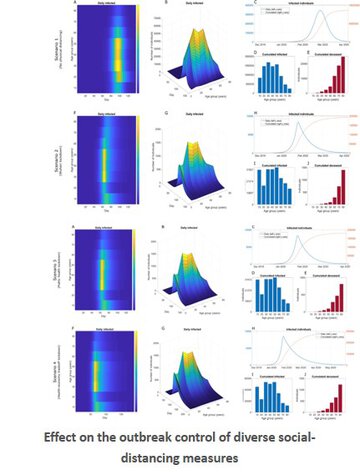Daniel Ortega-Quijano, Noe Ortega-Quijano. Impact of age-selective vs non-selective physical-distancing measures against coronavirus disease 2019: a mathematical modelling study
Int J Epidemiol. 2021
“We believe this novel approach to the design of alternative age-specific control measures will be a useful tool for proposing selective interventions adapted to each country". - Dr. Daniel Ortega Quijano -
Summary:
Background: There is a real possibility of successive COVID-19-epidemic waves with devastating consequences. In this context, it has become mandatory to design age-selective measures aimed at achieving an optimal balance between protecting public health and maintaining a viable economic activity.
Methods: We programmed a Susceptible, Exposed, Infected, Removed (SEIR) model in order to introduce epidemiologically relevant age classes into the outbreak-dynamics analysis. The model was fitted to the official death toll and calculated age distribution of deaths in Wuhan using a constrained linear least-squares algorithm. Subsequently, we used synthetic location-specific and age-structured contact matrices to quantify the effect of age-selective interventions both on mortality and on economic activity in Wuhan. For this purpose, we simulated four different scenarios ranging from an absence of measures to age-selective interventions with stronger physical-distancing measures for older individuals.
Results: An age-selective strategy could reduce the death toll by >30% compared with the non-selective measures applied during Wuhan's lockdown for the same workforce. Moreover, an alternative age-selective strategy could allow a 5-fold increase in the population working on site without a detrimental impact on the death toll compared with the Wuhan scenario.
Conclusion: Our results suggest that age-selective-distancing measures focused on the older population could have achieved a better balance between COVID-19 mortality and economic activity during the first COVID-19 outbreak in Wuhan. However, the implications of this need to be interpreted along with considerations of the practical feasibility and potential wider benefits and drawbacks of such a strategy.
Why do you highlight this publication?
No published article has modelled and compared the effect of age-selective vs non-selective physical-distancing interventions against COVID-19 on both mortality and economic workforce, nor proposed age-structured control measures based on both aspects.
Publication commented by:
Dr. Daniel Ortega Quijano
Dermatology Service of Hospital Universitario Ramón y Cajal



